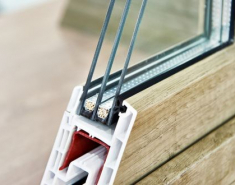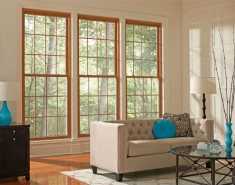Scratching the surface: Metallic glass implants
Artificial joints, blood-vessel stents, bone screws, and other implanted objects—crucial tools to help patients—carry risks related to the materials they’re made of. Valves and stents, for example, can provoke an inflammatory reaction that leads to deadly clotting. Joint replacements may gradually loosen and require replacement. And any implant can cause infection.
Such devices entail engineering tradeoffs: utility versus the strengths and weaknesses of their component materials. But a class of biomaterials called bulk metallic glasses could transform that calculus for future implanted medical devices, as well as for a host of other engineered objects. Found nowhere else in nature, these novel alloys may overcome many stubborn problems associated with today’s implants.
Shiny, gray, and pliable, bulk metallic glasses resemble ordinary metals but are stronger and harder than steel. They are nontoxic and resist corrosion and wear, making them well suited to dwell inside the body. They are elastic enough to change form and spring back with ease. And they are easily shaped.
“Usually, metals processing is a big pain. It’s kind of shocking—even 3D printing of metals is a big pain,” says materials scientist Jan Schroers, PhD, professor of mechanical engineering and materials science. “Metallic glasses have this ability to be formed like plastics.”
For example, when heated to temperatures achievable in a kitchen oven, a platinum-based bulk metallic glass softens to what Schroers describes as the consistency of refrigerated honey. “It doesn’t really deform by itself under its own weight, but it’s soft enough [that with modest] force you can deform it,” Schroers says.
In a cross-campus collaboration that has their lab personnel learning both metallurgic and wet-lab techniques, Schroers and Themis Kyriakides, PhD, associate professor of pathology and biomedical engineering at Yale School of Engineering and Applied Science, are exploring how bulk metallic glasses perform as biomaterials.
For one thing, the materials are largely harmless to mammalian cells yet hostile to bacteria. This property might make them useful as an antibacterial coating on artificial joints, surgical instruments, or hospital doorknobs.
Metallic glasses can also exert a druglike effect. When cells interact with the surfaces of implanted foreign bodies, they may go down the path of inflammation and rejection, or alternatively, toward a more desirable repair-like response. Which path the cells choose depends in part on the object’s tiniest surface features—its nanotopography. These surface irregularities attract nearby proteins, which in turn influence passing cells in various ways. Kyriakides and Schroers can manipulate these cell behaviors by molding specific patterns onto the surface of a metallic glass.
“We can dial in whatever we want to create in terms of the surface—they could be nanopatterned, they could be porous,” Kyriakides says. “These are [abilities] that are usually restricted to polymers, and we can do it with metals.”
That alone makes bulk metallic glasses “a fantastic toolbox,” Schroers says. “You can design cellular responses that are desirable for a specific application.”
One such application could be a coronary artery stent. Many stents on the market today are impregnated with a drug that diffuses into the body over time to prevent clotting and formation of fibrous deposits. But a bulk metallic glass stent with the right nanotopography could exert a similar effect, eliminating the need for a drug.
In orthopaedics, alloys made from calcium, magnesium, and phosphorus may gradually disintegrate in the body, a useful property for some types of bone hardware. Bulk metallic glasses can also be formed as strong, light foams—picture a solidified sponge—the density of which matches that of bone. That similarity is important because conventional joint implants tend to be stiffer than bone and absorb too much impact, allowing the surrounding bone to atrophy from disuse and resulting in a loosened, malfunctioning joint. An implant made from a metallic glass foam could avert those complications.
The term glass refers to a material whose atoms are arranged in an irregular non-crystalline pattern, and which reacts to heating by becoming viscous. To the eye and hand, metallic glasses look identical to ordinary metal. But familiar metal objects’ atomic structure is crystalline, comprising rows of atoms bonded in a lattice. Metallic glasses are more like a liquid in which chaotically moving homogeneous atoms have been frozen in time.
That homogeneity brings major advantages. Ordinary metal alloys’ crystals meet one another along countless microscopic edges called grain boundaries, which are vulnerable to slippage and corrosion. By contrast, metallic glasses are amorphous, homogeneous, and uniform in all directions throughout, making it harder for corrosive processes to gain a foothold.
Bulk metallic glasses are a brand-new material, according to Schroers. On our planet, at least, the co-occurrence of different metallic elements in a heated material that is abruptly cooled to form a glass has little or no precedent. (The closest analogue is volcanic glass, which consists mostly of silicon and oxygen, not metals.)
Oddly enough, cells survive and thrive on the new exotic materials. They seem especially at home on alloys based on the pricy element platinum, according to Kyriakides: “Our cells have pretty expensive taste,” he quips.
In 2014, Schroers founded a company, Supercool Metals, based on his patented Yale-owned technique for shaping bulk metallic glasses that can be used in modified manufacturing operations typically used in plastics processing.
“[We have] commercialized the ability to make very complicated shapes you can’t make with any other process, in this material that’s very attractive for a large range of applications,” he says. The company is working with NASA to develop parts for robots and satellites, and has developed a cellphone case with built-in flexible buttons that may allow the development of waterproof phones. Supercool Metals also manufactures tiny components for high-end watches.
Bulk metallic glasses are not ready for biomedical use just yet, but it might not take long before they are. In 2017, Kyriakides and Schroers built a glucose sensor from a platinum-based bulk metallic glass that is much more accurate than conventional sensors. Kyriakides estimates that such a sensor could be developed for clinical use within five years.
“We’re hoping that when people see our results, they can get excited about using these materials,” Kyriakides says. “We’ve barely scratched the surface.”
Source: https://bit.ly/2ktNexV









